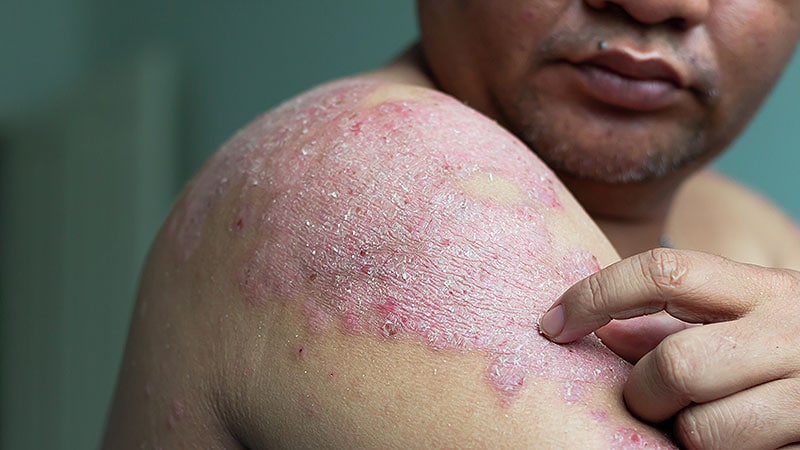Older adults with severe or refractory psoriatic disease face a unique challenge: Balancing the need for effective systemic treatment with the increased risk for serious infections. A cohort study recently published in JAMA Dermatology provides critical insights into the safety of systemic therapies for psoriatic disease in older adults.
The research, conducted by Aaron M. Drucker, MD, ScM, of the University of Toronto, Toronto, Ontario, Canada, and colleagues, analyzed population-based health administrative data from Ontario to evaluate the risk for serious infections associated with various systemic treatments in patients aged 66 years or older.
The findings, along with an accompanying editor’s note by Andrea D. Maderal, MD, of the Department of Dermatology, University of Miami, Miami, Florida, highlight the potential benefits of newer biologics targeting interleukin (IL)-12, IL-23, and IL-17, while also raising concerns about the risks for step therapy protocols that may delay access to these options.
Lower Infection Risk With IL-12/23, IL-17 Inhibitors
The study examined 11,641 older adults (median age, 71 years) with psoriasis or psoriatic arthritis who initiated systemic therapy between 2002 and 2020. Most (73%) had psoriasis without arthritis, and methotrexate was the most common systemic medication used in 49% of the patients and 58% throughout follow-up. Median follow-up was about 4.8 years, during which there were 1967 serious infections.
A total of 1410 patients (12%) were hospitalized for infections, most commonly pneumonia, urinary tract infections, sepsis, and cellulitis. When comparing infection rates during systemic therapy vs periods without treatment, researchers observed that biologic therapies targeting IL-12, IL-23, and IL-17 were associated with 35% lower rates of serious infections (relative risk [RR], 0.65; 95% CI, 0.48-0.88). Conversely, tofacitinib, a Janus kinase inhibitor, was linked to a higher relative RR for serious infections (RR, 2.89; 95% CI, 1.14-7.34). Methotrexate, other older systemic medications (cyclosporine, acitretin, sulfasalazine, and leflunomide), and anti–tumor necrosis factor (TNF) biologics did not significantly alter the risk for serious infections.
“For older adults with psoriatic disease, among whom the baseline risk of infection is higher than in younger populations,” the authors wrote, “biologics targeting IL-12, IL-23, and IL-17 may offer important safety benefits over other treatment options, which should be considered when making clinical and policy decisions.”
Implications for Step Therapy Policies
In the accompanying editorial, Maderal underscores the policy implications of the study’s findings, particularly in relation to mandated step therapy (MST) protocols.
In Canada, MST often requires patients with severe psoriasis to fail two of the three first-line systemic treatments before gaining access to biologics. Maderal argued that rigid step therapy mandates may inadvertently delay access to safer biologic treatments, potentially increasing the risk for severe infections in older adults.
“These findings highlight the need for more nuanced considerations when selecting ideal therapies for patients and the potential harms of blanket MST programs,” she wrote. “In older adults who are at higher risk for serious infections, consideration of patient-specific risk factors is critical, and the study by Drucker et al. provides evidence in support of direct initiation of newer biologic therapies in older adult patients with psoriasis who require systemic treatment.”
Maderal called for a more individualized approach to treatment selection, one that accounts for the unique risks and benefits of systemic therapies in older adults. She emphasized the need for healthcare policymakers to reconsider current step therapy frameworks, ensuring that the safest and most effective treatment options are available without unnecessary delays.
Study Limitations
While the study provides valuable real-world evidence, it has several limitations, the authors noted, including the reliance on administrative health data, which introduces potential inaccuracies in identifying infectious events. Additionally, the study did not differentiate individual drugs within therapeutic classes, nor did it assess dose-response relationships, they wrote. Residual confounding because of factors like psoriatic disease severity and race/ethnicity, which were not accounted for in the dataset, also remains a possibility.
Another consideration is evaluating whether these findings suggest immunomodulatory benefits within the IL-12, IL-23, and IL-17 classes, or if the protective effect comes secondary to improved management of psoriatic disease, the authors noted.
Asked to comment on the results, Joel M. Gelfand, MD, professor of dermatology and epidemiology and director of the Psoriasis & Phototherapy Treatment Center at the University of Pennsylvania, Philadelphia, highlighted the significance of the study findings. “It is difficult to establish a causal relationship from this type of study, but previously, we found a reduced risk of serious infection in psoriasis patients randomized to TNF inhibitors compared to placebo in a careful meta-analysis of time-to-event data.” Gelfand was not an investigator in the study.
“I think it is possible that highly effective treatment of psoriasis may lower the risk of serious infection by improving the barrier function of the skin, but more research is needed to prove this hypothesis,” he added.
The study was supported by a grant from the Canadian Institutes of Health Research (CIHR). Drucker’s disclosures included receiving CIHR grants during the study, institutional research grants from the National Eczema Association, Eczema Society of Canada, Canadian Dermatology Foundation, CIHR, National Institutes of Health, and Physicians Services Incorporated Foundation. One author reported receiving grants from AbbVie, Pfizer, Janssen, UCB, Novartis, and Eli Lilly and Company outside the submitted work; another author reported personal fees from Proof Diagnostics; advisory roles for Signal 1 outside the submitted work; holding a provisional patent for a dialysis prediction model; and serving as an expert witness on unrelated content.
Maderal, an editorial fellow at JAMA Dermatology, reported personal fees from argenX and was an investigator in Biogen and aTyr clinical trials (outside the submitted work). Gelfand’s disclosures included serving as a consultant for multiple pharmaceutical companies and receiving research grants (to the Trustees of the University of Pennsylvania) from Amgen, Bristol Myers Squibb, and Pfizer.
Jennifer Fisher is a Connecticut-based dermatology physician associate and freelance medical writer.
Source link : https://www.medscape.com/viewarticle/study-examines-safety-systemic-psoriasis-therapies-older-2025a10007lo?src=rss
Author :
Publish date : 2025-03-31 08:56:00
Copyright for syndicated content belongs to the linked Source.
